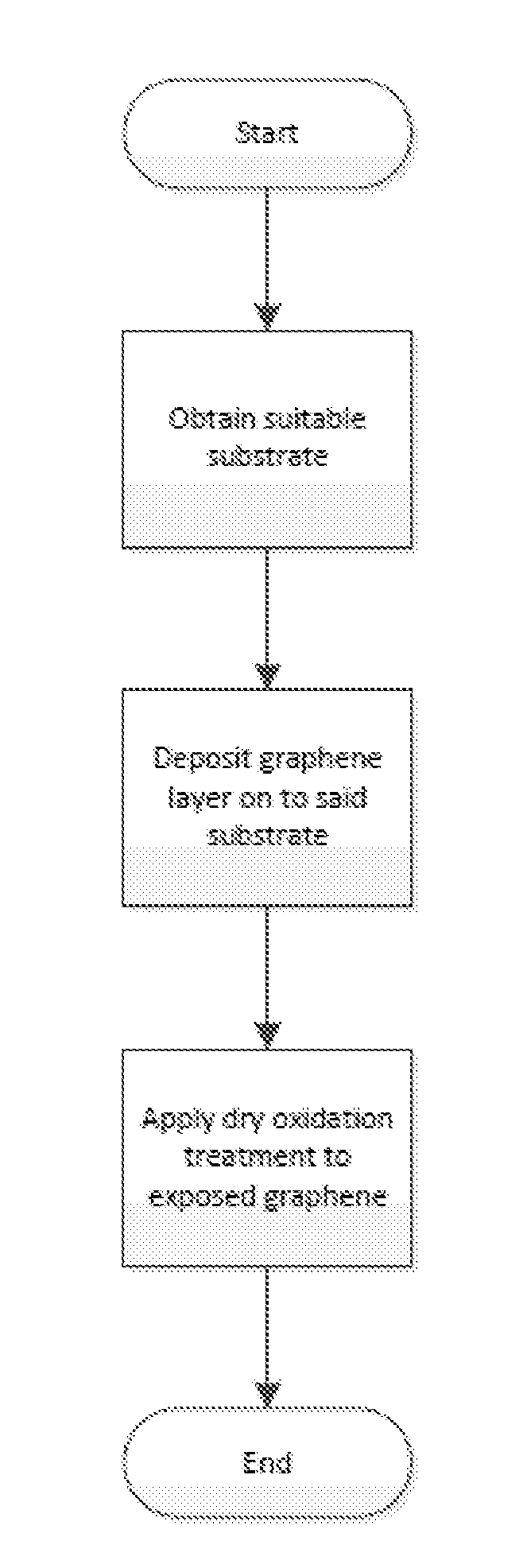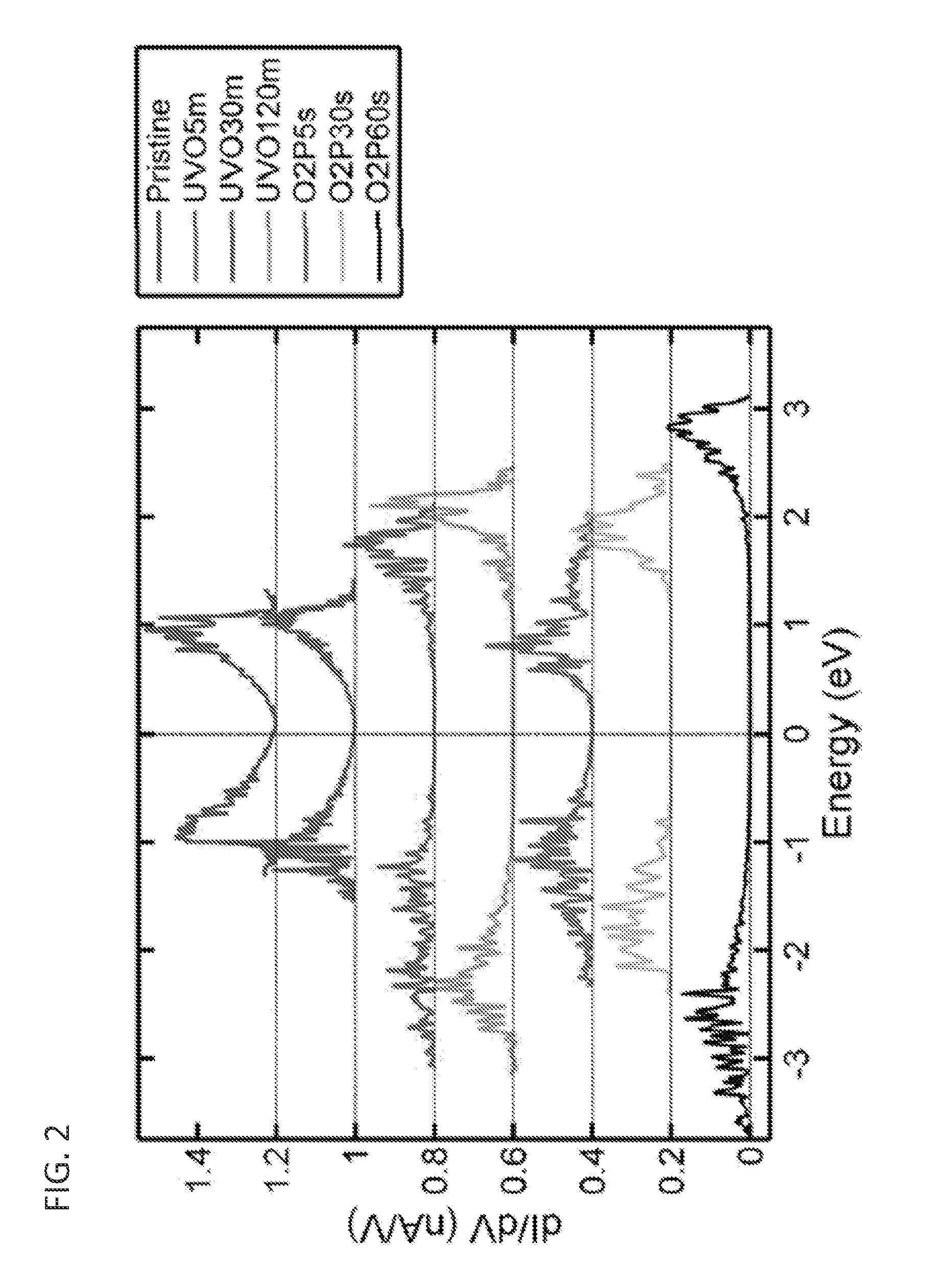Method for producing graphene oxide with tunable gap
a graphene oxide and gap technology, applied in the direction of solid-state devices, chemistry apparatus and processes, thermoelectric devices, etc., can solve the problems of limiting usability, significantly long time to complete, and less than ideal wet oxidation process, so as to achieve more expedient oxidation and safer oxidation treatment
- Summary
- Abstract
- Description
- Claims
- Application Information
AI Technical Summary
Benefits of technology
Problems solved by technology
Method used
Image
Examples
example 1
Studies
[0054]The atomically resolved image of pristine graphene samples obtained by scanning tunneling microscope (STM) exhibits a highly-symmetric hexagonal lattice structures, which is a typical signature of a pristine graphene layer. In agreement with previously reported study, these hexagonal lattice structures show an atomic spacing of ˜0.23 nm (FIG. 7b). (See, e.g., Mizes H A, et al., Physical Review B. 1987,36,4491, the disclosure of which is incorporated herein by reference.) Three distinct peaks of D band (˜1350 cm−1), G band (˜1580 cm−1) and G′ band (˜2700) can be seen in the Raman spectrum of the pristine graphene samples (FIG. 7c). (See, e.g., Dresselhaus M S, et al., Nano Lett. 2010,10,751-8; Reina A, et al., Nano Lett 2009,9,30-5; and Dresselhaus M S, et al., Annual Review of Condensed Matter Physics. 2010,1,89-108, the disclosure of which is incorporated herein by reference.) The peak intensity ratio between the disorder-induced D band and sp2 symmetry G band, ID / IG, ...
example 2
es
[0063]The presence of oxygen adsorbates in the oxidized graphene samples was further investigated using high-resolution XPS scans. Curve-fitting and deconvolution of the high-resolution XPS spectra of C 1s was performed using a Gaussian-Lorentzian peak shape with Shirley baseline correction. Deconvolution of the C 1s XPS spectra of both oxygen plasma and UV / ozone treated samples shows four distinct peaks associated with sp2 C—C (284.7±0.1 eV, FWHM 0.9 eV), C—O (285.2±0.1 eV, FWHM 1.45 eV), C═O (286.7±0.1 eV, FWHM 1.45 eV), and O—C═O (288.6±0.1 eV, FWHM 4 eV). (See, Yang D, et al., Carbon. 2009,47,145-52, the disclosure of which is incorporated herein by reference.) The C 1s XPS spectra of the pristine graphene samples show a very strong C—O peak which may be caused by a significant presence of hydroxyl or epoxide groups at the edge. These spectra also show a relatively weak C═O peak and the absence of a peak associated with O—C═O group (FIG. 9a). The O—C═O peak can be barely seen ...
example 3
es
[0068]The effect of both oxygen plasma and UV / ozone treatments to the electronic structure of graphene can be literally seen from the evolution of the atomically resolved images obtained by scanning tunneling microscope (STM). As graphene is oxidized, defects on the hexagonal lattice structure due to the presence of oxygen adsorbates in the form of oxygenated functional groups start to occur. For samples with low concentration of oxygen adsorbates, i.e. O2P5s and UVO5m samples, the degree of disorder is quite low such that the hexagonal lattice structures still can be recognized from the raw STM images without using any further image processing technique (FIG. 12a). At higher concentration of oxygen adsorbates, the distortion to the lattice structure is amplified such that the hexagonal patterns become much less apparent and more difficult to be recognized from the raw STM images. Fourier transformation of the raw STM images of O2P10s and UVO30m samples reveals a superposition of ...
PUM
| Property | Measurement | Unit |
|---|---|---|
| band gap | aaaaa | aaaaa |
| band gap | aaaaa | aaaaa |
| energy gap | aaaaa | aaaaa |
Abstract
Description
Claims
Application Information
 Login to View More
Login to View More - R&D
- Intellectual Property
- Life Sciences
- Materials
- Tech Scout
- Unparalleled Data Quality
- Higher Quality Content
- 60% Fewer Hallucinations
Browse by: Latest US Patents, China's latest patents, Technical Efficacy Thesaurus, Application Domain, Technology Topic, Popular Technical Reports.
© 2025 PatSnap. All rights reserved.Legal|Privacy policy|Modern Slavery Act Transparency Statement|Sitemap|About US| Contact US: help@patsnap.com



